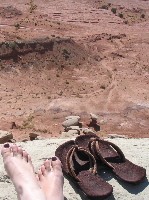AstroVino #1: Intro and Component Tasting
Tonight was the first class of the wine tasting class I'm taking this quarter. Offered by and at the home of one of the professors here, Rick, it's a ten week course covering over sixty wines from four continents. We've got a fun astronomy-filled group of graduate students, postdocs, professors, and a spouse or two. The basic goal of the course is for us to learn the language of wine, the kinds of wine we do and do not like, and how to pick which wines might go well with which dishes. (Given some of my past experiences with wines, this is probably a good thing.) Mostly for my own personal edification, I'm going to try to post my impressions of each week's class before I forget all the nice details.
This week we started off with a bit of a history lesson. I personally really like the idea of the first person to taste wine: grapes are stored in a jar, they ferment, some sad soul comes along and decides to fix everything by poisoning themselves, they take a drink, and hey!, everything seems a little bit better...
The first food of the evening was a handful of concord grapes. This was a real eye-opener for me. They tasted like artificial grape flavoring tastes... but in grape form!! Where have I been all these years?! Amazing, simply amazing. We examined how the juice tastes compared to the pulp (which is actually white), how the juice from the dark purple skin tastes compared to the skin and the pulp. And how bitter the stem is. The grape tasting was complemented by an Ohioan wine made from concord grapes.
The bulk of the class was dedicated to "component tasting." Did you ever do that thing in elementary school where you have to make a map of your tongue based on dipping cuetips into sugar water and salt water and bitter water and swabbing it in your mouth? It was like that, but with wine and no little kids going, ewwwwww. We were given a simple base wine (Almaden Mountain Chablis, a white box wine) which had been enhanced with six different flavors. The components were acidity (citric acid), sugar (sucrose), sweetness (glycerine), tannin (... grape tannin), oak (soaked oak chips in the wine), and simulated oxidation (adding dry Fino sherry). Most of the tastes were fairly subtle, but the tannin and the oak were quite strong. Apparently, by the way, if a wine smells like sherry (and thus not like "wine"), it is probably due to an overabundance of acetaldehyde, and means the wine has "gone bad."
The class finished off with an assignment: taste six different wines (three whites and three reds) and try to identify the components in each. The whites were an NV Gazela Vinho Verde (Portugal), a 2005 Reisling Piesporter Michelsberg Spatlese (Germany), and a 2004 Clos du Bois North Coast Chardonnay (California). The reds were a 2004 Milton Park Syrah (Australia), a 2004 Santa Rita Riserva Cabernet Sauvignon (Chile), and a 2004 Louis Drouhin La Foret Pinot Noir. Normally, I shy away from white wines as I have never really liked them, and I usually find even cheap red wines quite potable. I'm also not exactly known for trying new things, but I figure if I'm going to be doing this class, I should try everything.
And so I did. The Vinho Verde, a light fizzy chilled wine, was quite tart; it's main goal in life is to be a refreshing summer wine. The Riesling was sweet and fruity; apparently, wines from colder climates are usually more acidic, but 2005 was an unusually hot season (according to the German sitting across the table from me), which probably explains why this bottle was so sweet. And the Chardonnay ... tasted like oak. And so did the next one. And the one after that. Even after I had some goat cheese on bread, they all tasted like oak. Have you ever been in a wood-panelled sauna? This taste of oak is like that, but consuming your entire head. Even the wines that wouldn't recognize the inside of an oak barrel if they saw it were reeking of oak after the Chardonnay. It's hours later now and I've had ice cream and brushed my teeth multiple times and my nose and sinuses are still asking me what the hell I just put them through.
But at least I know now to shy away from Chardonnays and anything claiming to be oak-intensive ....


2 comments:
Very cool! My nose could use a little training. I think I will try to find a class like that. Interesting that the boxed wine is like a "baseline". I've heard of that before, but never really knew how it worked.
Fly by Night
http://boxedwinespot.blogspot.com
Hi there!
The boxed wine was okay by itself, but it just didn't have much "backbone," and so was able to take up the other flavors efficiently. And we were assured that no Chablis grapes were harmed in the making of the wine.
And I'm definitely hoping I'll have a more "discerning palate" by the end of this!
Post a Comment